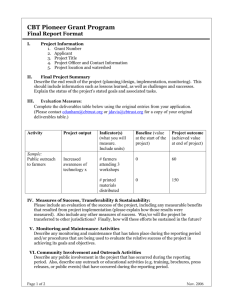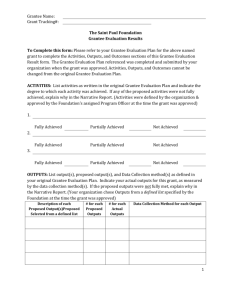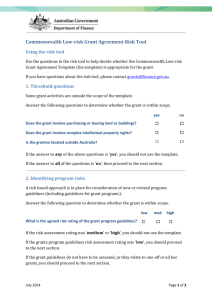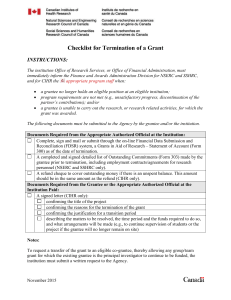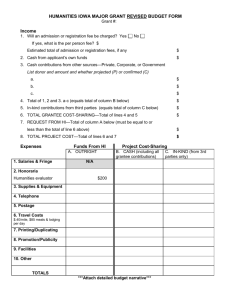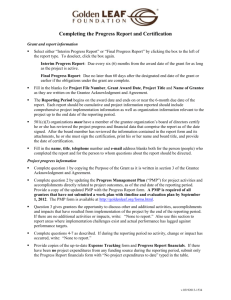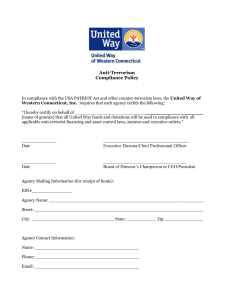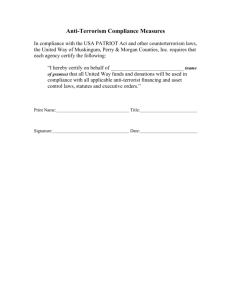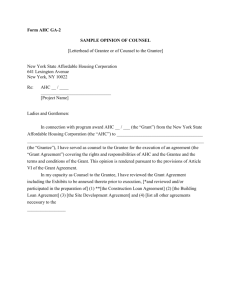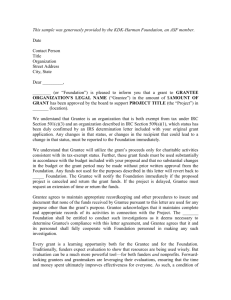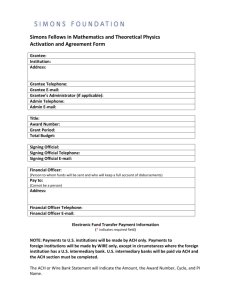Start with Logical and Reasonable Outcomes
advertisement
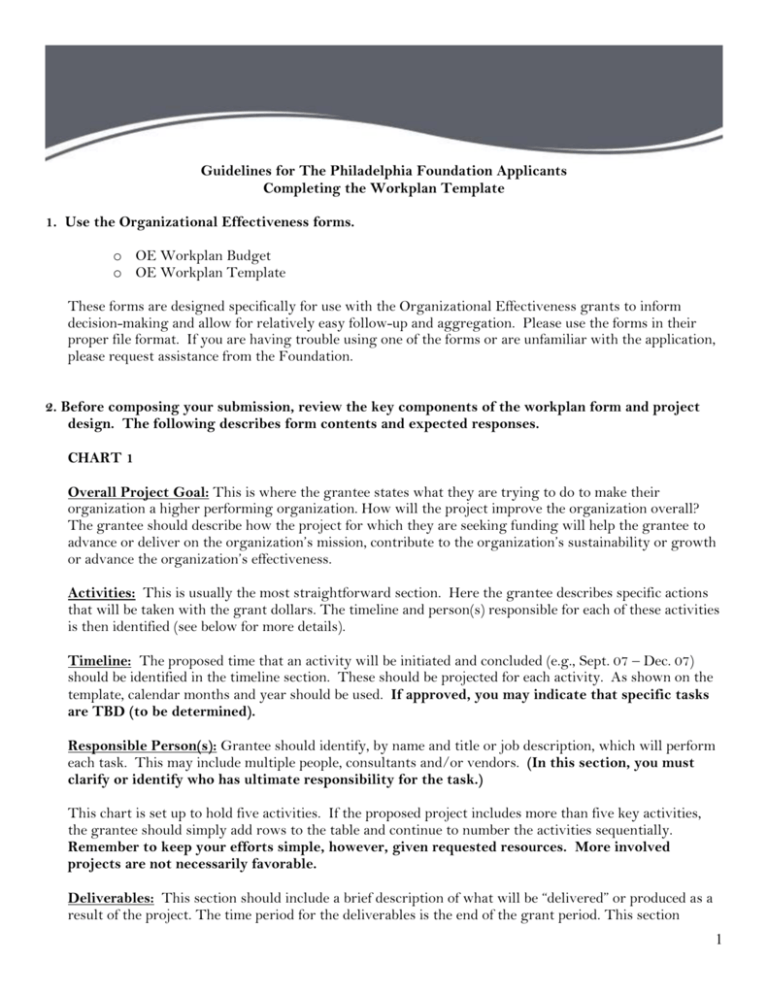
Guidelines for The Philadelphia Foundation Applicants Completing the Workplan Template 1. Use the Organizational Effectiveness forms. o OE Workplan Budget o OE Workplan Template These forms are designed specifically for use with the Organizational Effectiveness grants to inform decision-making and allow for relatively easy follow-up and aggregation. Please use the forms in their proper file format. If you are having trouble using one of the forms or are unfamiliar with the application, please request assistance from the Foundation. 2. Before composing your submission, review the key components of the workplan form and project design. The following describes form contents and expected responses. CHART 1 Overall Project Goal: This is where the grantee states what they are trying to do to make their organization a higher performing organization. How will the project improve the organization overall? The grantee should describe how the project for which they are seeking funding will help the grantee to advance or deliver on the organization’s mission, contribute to the organization’s sustainability or growth or advance the organization’s effectiveness. Activities: This is usually the most straightforward section. Here the grantee describes specific actions that will be taken with the grant dollars. The timeline and person(s) responsible for each of these activities is then identified (see below for more details). Timeline: The proposed time that an activity will be initiated and concluded (e.g., Sept. 07 – Dec. 07) should be identified in the timeline section. These should be projected for each activity. As shown on the template, calendar months and year should be used. If approved, you may indicate that specific tasks are TBD (to be determined). Responsible Person(s): Grantee should identify, by name and title or job description, which will perform each task. This may include multiple people, consultants and/or vendors. (In this section, you must clarify or identify who has ultimate responsibility for the task.) This chart is set up to hold five activities. If the proposed project includes more than five key activities, the grantee should simply add rows to the table and continue to number the activities sequentially. Remember to keep your efforts simple, however, given requested resources. More involved projects are not necessarily favorable. Deliverables: This section should include a brief description of what will be “delivered” or produced as a result of the project. The time period for the deliverables is the end of the grant period. This section 1 should answer the question: what products will this grant buy? In United Way language, these are the outputs of the grant – but please note that there is just one box to describe the set of deliverables that are likely to be produced because we know that multiple activities sometimes lead to a single product and sometimes multiple deliverables are produced from single activities. REPORTING NOTE: You will be asked to complete a report at the close of the grant period in which you will be asked to describe the deliverables of the grant. CHART 2 Project Outcomes: Three types of information should be reported in the columns provided. All of this describes changes in condition, status, knowledge, attitudes, or behaviors that happen as a direct result of the project activities. The time period for the outcomes is one year after the close of the grant period. This section answers the MOST important question: how will this make your organization better? Specific information includes the following. Outcomes: Here the grantee describes what change will occur that make the organization better by one year after the close of the grant period. The term outcomes should not include giant leaps of faith or “pie in the sky” possibilities. Rather, the grantees can use this chart to show how the use of their grant funds will allow them to complete specific activities, which lead to organizational strengthening. The outcomes here should reiterate or show how the organization will change through the grant. (They may also show how improved organizational capacity will ultimately lead to improved outcomes for participants in grantee programs.) Indicators: For each outcome there is a space to describe how the grantee will know the outcome has been achieved (i.e., what will indicate achievement). This section answers the question: How will you know whether the outcome has been achieved? This should NOT be a list of ways to collect information about the outcome, rather a statement of how the grantee will determine whether an outcome has been achieved (i.e., specification of the “I’ll know it when I see it rule.”) Often outcomes will have more than one indicator. Sources Of Information: This section is for the grantee to identify how they will get information about the indicators – who they will talk to, what they could look at, or how they might use some specific data collection strategies (like surveys) to collect the information on the indicators that will help determine whether their outcomes have been achieved. This may certainly include simple observation or a review of the product of the work or some records automatically kept that show the outcome has actually happened. REPORTING NOTE: You will be asked to complete a report one year after the close of the grant period in which you will be asked to report on the results of the outcomes listed in the work-plan. . 2 MORE TIPS AND ADVICE REGARDING ORGANIZATIONAL EFFECTIVENESS PROJECTS 1. Start with Logical and Reasonable Outcomes What makes an outcome logical and reasonable? There is a logical connection between the activities and the outcome. Based on experiences, the context within the organization (i.e. new staff, size of staff), and the resources that we have, it is reasonable to believe that the outcome can be accomplished within the timeframe that we have established. The information being collected to track this outcome will help the organization and stakeholders to know more about how the organization might improve the capacity building project and organizational effectiveness overall. Each outcome specifies both the group or condition or process (e.g., staff, data storage system) targeted for change and what they hope to change about that (e.g., knowledge, speed at which client data can be retrieved). 2. Use Caution when Specifying Outcomes There is no right number of outcomes. Be sure to think about when to expect outcomes (could what you are proposing really happen within one year?) Outcomes, even longer-term outcomes, should not go beyond the project’s purpose. 3. Questions to Ask When Identifying Indicators 1. 2. 3. 4. 5. 6. What does this outcome look like when it occurs? What would tell you it has happened? What could be counted or tracked? Can it be observed? Does the indicator you have identified tell you whether the outcome has been achieved What evidence do you need to see to be convinced that things are changing or improving? 3 The “I’ll know it when I see it rule.” Example: I’ll know our mobile communication systems will improve our service to clients when I see an increase in the number of clients served remotely and when I see a decrease in the # of days it takes to process client cases following initial intake off-site and an increase in client satisfaction among clients served remotely, ADVICE FOR REVIEWING YOUR WORKPLAN TEMPLATES Before you submit your work-plan, see if you can answer the following affirmatively. * Are all in agreement that the potential outcomes identified are logical and reasonable given available financial resources and time. * Are there too many or too few proposed outcomes given the activities proposed and the amounts requested? * Could the outcomes actually be accomplished during the time of the grant or are they too ambitious given resources? * Are the potential outcomes of the project important to the organization? the Foundation? * Are the potential outcomes stated in clear and precise terms? * Are relationships between outcomes and indicators clear? Will the grantee and the Foundation know the outcome has occurred when they see or learn about the indicator? * Are the sources of information likely to clarify whether the outcome has occurred? Are there other sources of information that could also yield what is needed more easily? Does your organization have the capacity and necessary assistance to get the information needed? 4

